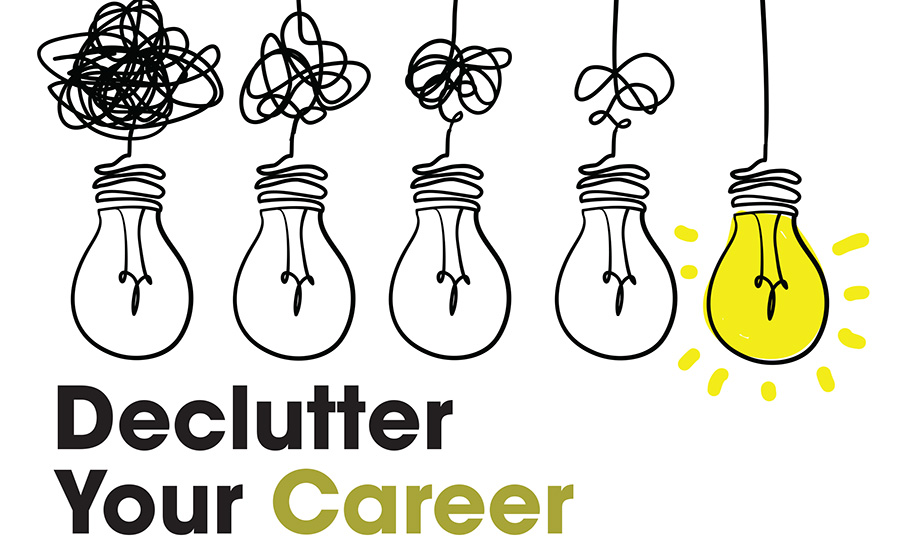Declutter Your Career

Think of your bookshelf, or for those of you who are digitally minded, think about your e-reader or Audible subscription. You likely have hours of distilled wisdom in your possession, with many more waiting to be added today, tomorrow, and every day after. This leads to an issue of clutter and of wondering which ideas are best, who you should listen to, and how to decide which advice or method(s) to follow.
Even without the resources on your bookshelf, you are likely equipped to elevate your career or the business you participate in, but you may have missed a step or two along the way. In his book, The Learned Disciplines of Management: How to Make the Right Things Happen, author Jim Burkett’s first three disciplines are Planning, Organizing, and Measuring Performance.
While visiting hundreds of offices over the last half-decade, I noticed a common theme of the planning and organizing steps often being skipped. If you are currently measuring KPIs or other performance management indicators without a plan for how to use the information or having an organized path for how you will get to your goals, you are doing a disservice to yourself and those you work with.
The following four steps will help you organize your thoughts and aid in deciding which method or workflow to use in achieving your goals.
Dispose of the Clutter
There are excellent resources for career and small business planning, with more being created every day. I love the planning process and enjoy seeing the moment an individual or team recognizes that their goals are likely to be accomplished. But it’s just after that moment when a goal has been set that the wisdom of a bookshelf often gets in the way. Thoughts enter your mind about whether you should grow ten times, write everything down on one page, consider five forces that affect you, or look for new places to find cheese.
It’s at this point when there is one question that should become a mantra to begin organizing your professional life: “How does this individual idea help me achieve the goal I set during planning?”
The first step in organizing is to dispose of the clutter. If you are unsure about an idea or do not believe it will be of help, discard it. Do not throw the book itself out, but certainly do not reference that particular process while attempting to achieve this particular goal. Subtracting ideas at the onset will save hours of time later in the process.
After getting rid of this clutter, the next three steps will help you make a connection between your goals and the resources you will need to achieve them.
Recognize Needed Activities
During the recognition phase you should ask yourself: “Do I have everything I need to accomplish my goal?” You may not currently have the resources to achieve the long-term goals you set in the planning phase. If this is the case, begin to pursue activities that will create the platform to build those resources. Begin by identifying the routine daily, weekly, and monthly activities that will help you get closer to your goals. Once you recognize these activities, segment them further into steps, processes, procedures, and the needed resources. For instance, if your goal is to obtain a certificate, you will need to build in research, study, testing, fees, and accountability to achieve your goal. Each of these activities have components that must be identified, along with costs associated with the effort taken to master each one. Later in the process, each activity will produce a result that can be observed and measured to show how effective the activity was in achieving the goal.

Evaluate Activities
Now that you have recognized activities, the key question is “How?”—how can this process be done quicker, cheaper, faster? By asking variations of this question, you can optimize how you will approach the activities identified in the above step. Ultimately, you will set the standard for the way tasks are completed.
Organizing your thoughts on how you want to complete a task helps to eliminate unnecessary effort. And even though much of the clutter is reduced by disposing of unproductive ideas, another review of activities should be completed at this point. Eliminating more activities now will further increase your chance of success in reaching your goal.
Maximize Resources
The final step in choosing how to implement and measure performance can best be summed up with two questions: “How effective will these tools be?” and “How efficient are these tools?” A tool can be people, equipment, supplies, materials, or work products (like the one created from going through this process). There will be a limited number of resources or tools that you can use to make progress on your goals, so it is important that you use those resources wisely.
Think of the last time you struggled to finish a physical product. Were you short on materials or time? Did you have to work to gather those materials or create a substandard product due to time limitations? In most instances, these shortcomings at the end of a project can be tied back to poor planning at the beginning.
Critically consider the tools you will use to make progress. Maximize their effectiveness and efficiency to create an atmosphere that will allow the product or skill you focus on to shine. This is the key to managing your progress and it will pay dividends during the measuring phase.
There will still be leftover clutter after following this process. Many of the ideas on your bookshelf will creep back in and make achieving your goals more difficult. Be diligent. Work through the steps of disposing of ideas that are not relevant, recognizing activities, evaluating activities, and maximizing resources on a regular schedule. I recommend at least an annual review of your career or business in both the planning and organizing of your goals.
By getting rid of the clutter, you can get to the discipline of measuring progress through KPIs or other performance management indicators with greater success.
Looking for a reprint of this article?
From high-res PDFs to custom plaques, order your copy today!







